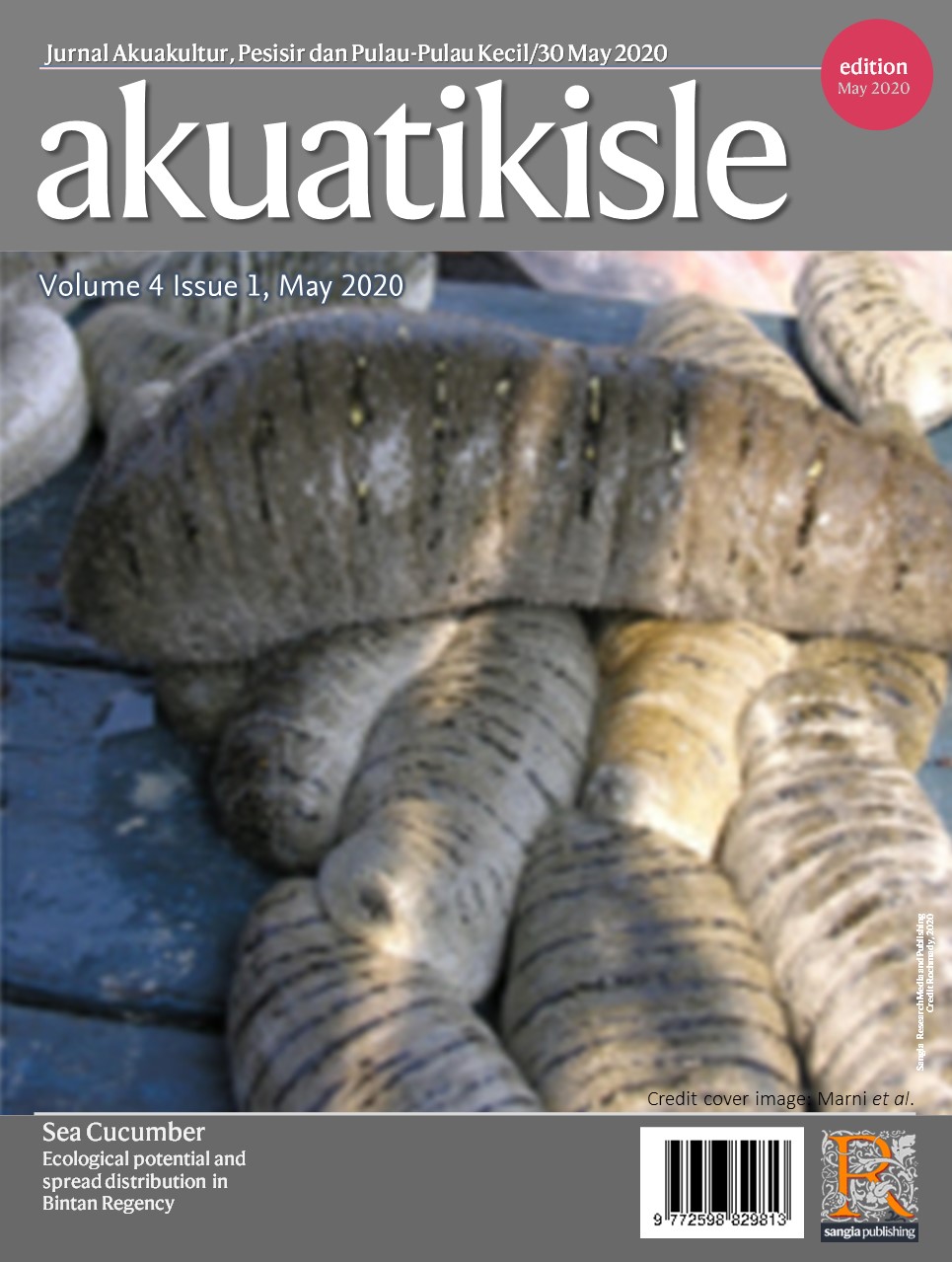Akuatikisle: Jurnal Akuakultur, Pesisir dan Pulau-Pulau Kecil
Full Length Article
Eating habits of sea cucumber (Holothuria scabra) and sea cucumber sap (Holothuria vagabunda) in Karas waters, Batam City, Indonesia
Kebiasaan makan teripang pasir (Holothuria scabra) dan teripang getah (Holothuria vagabunda) di Perairan Karas, Kota Batam, Indonesia
Highlights
Generate NLP AI by Wizdam ID.
Abstract
Penelitian bertujuan untuk mengetahui jenis makanan yang dimakan teripang pasir (H. scabra) dan teripang getah (H. vagabunda), mengetahui kebiasaan makan teripang pasir (H. scabra) dan teripang getah (H. vagabunda) di perairan Karas Kecamatan Galang Kota Batam. Penentuan titik sampling menggunakan metode purposive sampling, dan pengambilan sampel dilakukan dengan menggunakan metode sapuan. Hasil penelitian ditemukan 3 jenis makanan Teripang Pasir yaitu dengan persentase, Bacillariophyceae 49,82%, Sarcodina 2,23%, Crustacea 24,33%, dan 5 jenis makanan Teripang Getah dengan persentase, Bacillariophyceae 50,75%, Sarcodina 3,91%, Crustasea 4,83%, Copepoda 0,52%, dan Serat Lamun 0,30%.
Abstract
The aim of this study was to find out the types of food eaten by sea cucumber sand (H. scabra) and sea cucumber (H. vagabunda), to know the habits of eating sea cucumber (H. scabra) and sea cucumber (H. vagabunda) in Karas waters, Galang District, Batam City. Determination of sampling points using results of the study found 3 types of sea cucumber food namely percentage, Bacillariophyceae 49,82%, Sarcodina 2,23%, Crustacea 24,33%, and 5 types of food Sea Cucumber Seafish with percentage, Bacillariophyceae 50,75%, Sarcodina 3,91%, Crustacea 4,83%, Copepoda 0,52%, and Seagrass Fiber 0,30%.
Keywords
Introduction
Section snippets
Material and Methods
Materials and methods from the full-text PDF of this article cannot be displayed.
Results
Results from the full-text PDF of this article cannot be displayed.
Discussion
Discussion from the full-text PDF of this article cannot be displayed.
Conclusions
Conclusions from the full-text PDF of this article cannot be displayed.
Acknowledgment
Acknowledgment from the full-text PDF of this article cannot be displayed.
Competing interest
The authors declare that they have no known competing financial interests or personal relationships that could have appeared to influence the work reported in this paper.
Conflict of interest
The authors declare that the research was conducted in the absence of any commercial or financial relationships that could be construed as a potential conflict of interest.
Ethical approval acknowledgements
No ethical approval required for this article. All procedures followed were in accordance with the ethical standards of the responsible committee on human experimentation (institutional and national) and with the Helsinki Declaration of 1975, as revised in 2008 (5)
Supplementary files
Data sharing not applicable to this article as no datasets were generated or analysed during the current study, and/or contains supplementary material, which is available to authorized users.
Bibliographic Information
Cite this article as:
-
Submitted
29 July 2019 -
Revised
9 October 2019 -
Accepted
22 April 2020 -
Published
31 May 2020 -
Version of record
25 June 2020 -
Issue date
31 May 2020
-
Academic subject
Fisheries; Fisheries Science
Copyright
Copyright © 2020 Deskarosa Rahma Dini, Susiana Susiana, Ani Suryanti. Sangia Research Media and Publishing. Production and hosting by Sangia (SRM™).  This work is licensed under a Creative Commons Attribution-ShareAlike 4.0 International License.
This work is licensed under a Creative Commons Attribution-ShareAlike 4.0 International License.
Disclaimer: All claims expressed in this article are solely those of the authors and do not necessarily represent those of their affiliated organizations, or those of the publisher, the editors and the reviewers. Any product that may be evaluated in this article or claim that may be made by its manufacturer is not guaranteed or endorsed by the publisher.
Comments on this article
By submitting a comment you agree to abide by our Terms and Community Guidelines. If you find something abusive or that does not comply with our terms or guidelines please flag it as inappropriate.



